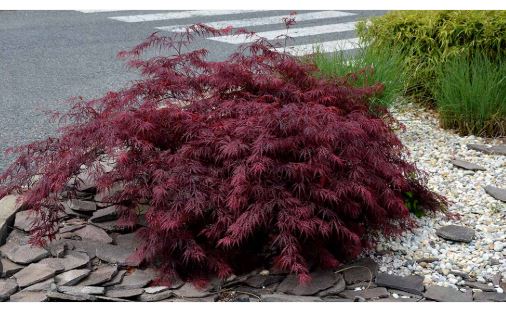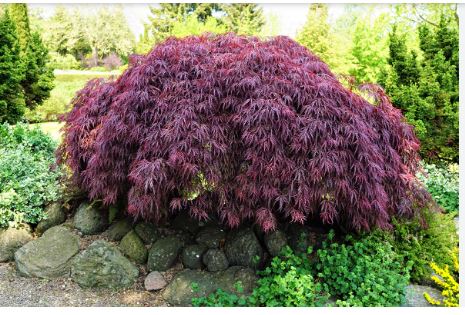
Dwarf Japanese maples are primarily cultivars of Acer palmatum, a species within the Sapindaceae family, which also includes maples, horse chestnuts, and soapberries. The genus Acer contains approximately 150 species of deciduous trees and shrubs, with Acer palmatum being the most prominent for dwarf selections, alongside occasional contributions from Acer japonicum and Acer shirasawanum. These dwarfs are horticulturally developed for their compact size through selective breeding or grafting, often labeled with cultivar names like ‘Crimson Queen’ or ‘Mikawa Yatsubusa’. Their classification as cultivars reflects centuries of Japanese horticultural artistry, emphasizing ornamental traits suited for small gardens or bonsai.
Dwarf Japanese maples are compact, deciduous trees or shrubs, typically growing 2–10 feet (0.6–3 meters) tall and wide, with forms ranging from upright and mounded to weeping and cascading. Their palmate leaves, 1.5–5 inches (4–13 cm) long, feature 5–9 finely lobed, serrated edges, showcasing colors from green and red to purple or variegated patterns, with fall displays of scarlet, orange, or gold. Leaves may be broad or finely cut (dissectum types), adding textural variety. In spring, small, reddish-purple flowers appear, followed by paired samaras (winged seeds), 0.5–1 inch (1.3–2.5 cm) long. Their slow growth (6–12 inches/15–30 cm annually), delicate twigs, and colorful winter bark enhance their year-round appeal in confined spaces.
Acer palmatum, the parent species of dwarf Japanese maples, is native to Japan, South Korea, eastern China, and parts of Mongolia and Russia, where it grows in temperate forests, on wooded slopes, and as an understory plant in mountainous areas with cool, moist conditions. Dwarf cultivars, however, are not found in the wild, originating from centuries of cultivation in Japan for garden and bonsai use. Today, they are grown globally in temperate regions, including North America, Europe, Australia, and New Zealand, thriving in gardens, urban parks, and nurseries. Their distribution is entirely horticultural, reliant on propagation rather than natural spread.
Dwarf Japanese maples are hardy in USDA zones 5a–9b, tolerating winter lows of -20°F (-29°C) in colder zones, though newly planted or young trees may need protection below -10°F (-23°C). They flourish in temperate climates with mild summers, ideally 50°F to 80°F (10°C–27°C), suited to coastal and inland areas. In zones 8–9, they require afternoon shade and consistent moisture to prevent leaf scorch in heat. Below zone 5a, they can be grown in containers and sheltered during harsh winters, thriving with well-drained, slightly acidic soil (pH 5.5–6.5) and careful attention to avoid drought or waterlogging.

Dwarf Japanese Maples
Crimson Queen
A weeping, lace-leaf variety with delicate, crimson-red foliage that holds its color through summer, turning scarlet in fall. Growing to 8–10 feet tall and wide, it’s ideal for cascading over walls, in rock gardens, or as a container specimen. Its low-branching form adds drama to shaded patios or Zen gardens, thriving in zones 5–8 with partial shade.
Tamukeyama
Known for its heat tolerance, this weeping maple has deep purple-red, lacy leaves in summer, shifting to bright red in fall. Reaching 6–8 feet tall and 8–12 feet wide, it suits borders or containers. Its waxy, red bark adds winter interest. Plant in zones 5–8 in part shade to full sun for vibrant color.
Shaina
A dense, upright dwarf with bright red spring foliage maturing to deep maroon, then crimson in fall. Growing to 6–8 feet tall and 8–10 feet wide, it’s perfect as a small lawn tree, entryway accent, or potted focal point. Thrives in zones 5–8 with part shade to full sun, offering bold color in compact spaces.
Rhode Island Red
This upright dwarf boasts crimson-red leaves in spring, burgundy in summer, and bright red in fall, with a rounded crown. At 5–6 feet tall and 4–5 feet wide, it’s great for patios, rock gardens, or understory planting. Hardy in zones 5–9, it prefers partial shade to maintain its vivid hues.
Viridis
A weeping, lace-leaf maple with vivid green foliage turning gold to crimson in fall. Growing to 6–8 feet tall and 8–10 feet wide, it excels near water features, in containers, or as an understory accent. Zones 5–8, part shade to dappled sun, ensure its delicate leaves shine without scorching.
Waterfall
Similar to Viridis but with slightly larger, lime-green lacy leaves, this weeping dwarf reaches 4–6 feet tall and wide, displaying yellow-orange fall color. Its cascading form is stunning in rock gardens or spilling over retaining walls. Zones 5–8, it prefers partial shade for best foliage vibrancy.
Koto no Ito
Translating to “harp strings,” this upright dwarf has fine, strap-like green leaves with crimson tips in spring, turning orange-gold in fall. At 5–7 feet tall and 3–4 feet wide, it’s ideal for small courtyards or bonsai. Zones 5–9, it thrives in full sun to part shade, adding delicate texture.
Mikawa Yatsubusa
A compact, layered dwarf with dense, green foliage shifting to gold-scarlet in fall. Growing to 4–6 feet tall and 3–4 feet wide, its sculptural form suits containers, rock gardens, or Zen designs. Hardy in zones 5–9, it prefers part shade to full sun for optimal leaf color.
Beni Hoshi
Known as “Ruby Stars,” this upright dwarf has bright red spring leaves fading to rusty green, then scarlet in fall. Reaching 4–5 feet tall and wide, it’s perfect for pots or fairy gardens. Zones 5–9, it thrives in part shade to full sun, offering a compact burst of color.
Coonara Pygmy
A rounded dwarf with pale pink-green spring leaves turning orange-yellow with red splashes in fall. At 6–8 feet tall and wide, it’s suited for containers or small beds. Zones 5–8, it prefers full sun to part shade, providing a long-lasting, colorful display in tight spaces.
Kamagata
A drought-hardy, upright dwarf with bright green, fan-shaped leaves turning yellow-orange in fall. Growing to 6–8 feet tall and 4–5 feet wide, it’s great for bonsai, patios, or borders. Zones 5–9, it tolerates full sun to part shade, adding resilience to sunny yards.
Butterfly
This upright dwarf features variegated green leaves with pink and white margins in spring, turning magenta-red in fall. At 6–8 feet tall and 4–5 feet wide, it’s ideal for containers or shaded gardens. Zones 5–8, part shade preserves its delicate variegation, creating a soft focal point.
Red Dragon
A weeping, lace-leaf cultivar with brilliant red foliage holding through summer, turning vibrant scarlet in fall. Reaching 6–8 feet tall and wide, it’s perfect for containers, rock gardens, or as a specimen. Zones 5–8, part shade to full sun enhances its rich color.
Golden Falls
A weeping dwarf with pink spring foliage maturing to golden-yellow, then orange-red in fall. Growing to 4–5 feet tall and 5–6 feet wide, it suits hanging baskets or cascading over walls. Zones 5–9, it thrives in part shade to full sun, offering a glowing accent.
Tattoo
An ultra-compact dwarf with layered, green leaves and pink spring flowers, turning gold-scarlet in fall. At 2–4 feet tall and wide, it’s perfect for bonsai, small containers, or rock gardens. Zones 5–9, part shade to full sun ensures its tiny stature shines in cozy spaces.